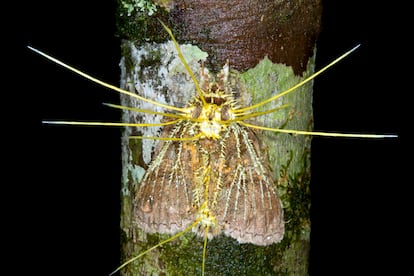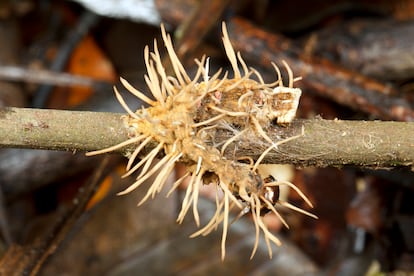Zombie Insects: The Disturbing 'Mind Control' Relationship Between Bugs and Parasites

The spore is ten times thinner than a human hair, but that's enough to become a lethal threat. All it needs is for an ant to walk on it. The insect has no way of knowing, but at that very moment, the tiny cell has attached itself to its exoskeleton, passed through, and now a parasite develops inside, growing until it reaches the nervous system. No one can explain how it does this , but in a very short time, the fungus takes control of the ant and bends it to its will.
Days later, in a completely atypical gesture, the tiny worker moves away from the route that connects its nest to the rest of the jungle. It climbs up a tree trunk until it finds a leaf—not too high, not too low—and sinks its mandibles into it. The ant dies, and its executioner finally reveals itself: the imposing stem of an Ophiocordyceps unilateralis sprouts from the insect's head , now once again releasing spores that will patiently disperse until they find new victims.
This infectious fungus, which specializes in attacking ants , altering their behavior, and using them to reproduce, exists in the real world, but it became famous in fiction. In the video game and television series The Last of Us, there are fungi that parasitize and zombify humans. They are called Cordyceps , cousins of those that hunt ants. But it's not the only parasite capable of controlling its host. In fact, there's a name for the victims: zombie bugs.
American science journalist Mindy Weisberger has just published Rise of the Zombie Bugs , published in English by Johns Hopkins University Press and not yet translated into Spanish, a book that explores the disturbing phenomenon of zombification in nature, far from the Hollywood spectacle.
“There's something about zombies that I find particularly intriguing,” Weisberger says in a video interview with EL PAÍS from New York, where he lives and collaborates with museums and science documentaries. “The idea of losing free will, of having something external control your body while you're still technically alive, is unsettling,” he adds. Parasites They reproduce by rewriting the neurochemistry of their victims, transforming them into the "living dead." Viruses, worms , fungi, or wasps. The list of zombie-forming species outside of fiction is long and varied.
Although these disturbing relationships between species exist and date back millions of years, entomology still doesn't fully understand how they work. "Scientists are just beginning to unravel the details. How they manipulate, what chemical pathways they use, what neural mechanisms are involved—it's all very mysterious and fascinating," explains the author. But to understand zombification , we must first understand parasitism.
The term “parasite” was first used in the 16th century, and its origins can be traced back to ancient Greek, where parasitos means “one who eats at another’s table.” “It’s different from a symbiotic relationship,” Weisberger writes, “because in those cases, both living beings enjoy the benefits. When it comes to a parasite, it’s the only one who benefits from the arrangement.”
The most cinematic example —and the communicator's favorite—is that of the so-called "zombie snail." The worm Leucochloridium paradoxum begins life in bird feces, where its eggs are accidentally ingested by a snail. Once inside, the larvae hatch and travel to the mollusk's tentacles, swelling and shaking them to resemble a caterpillar. The parasite takes control and forces the snail out of the shadows and into full daylight. Birds, attracted by its caterpillar-like appearance, peck at it, and the worms enter the animal's digestive system. Thus, everything begins again. "It's a complex cycle, but visually stunning and evolutionarily fascinating," notes Wesiberger.
Millions of years of parasitic relationshipsThe first evidence of a parasitic relationship comes from the sea and dates back 500 million years. These are the remains of small invertebrates called brachiopods that inhabited an ocean that occupied present-day southern China. Preserved parts of their shells reveal mineralized tubes constructed by tiny worms that likely stole food from their hosts.
“The parasitologists I interviewed for the book joke that the first life form was free-living and the second was already parasitic,” the author emphasizes. Of the approximately 7.7 million known animal species, an estimated 40% are parasitic. And the strategy has evolved independently at least 223 times throughout history. When asked how different control strategies have developed, Weisberger responds that for researchers, “ it's difficult to know because parasitic behavior is complex, and many relationships cannot be replicated in a laboratory.” But there are clues.

It's known, for example, that many zombifiers don't introduce new substances into their victims, but rather manipulate the chemicals already present in their hosts and use them to their advantage . In other cases, they actually "drug" them, as happens with jewel wasps. These insects turn cockroaches into functional zombies, which serve as living shelters for their larvae.
The process is surgical: the wasp first stings the cockroach in the thorax, paralyzing its front legs. It then delivers a second sting directly to the brain, where it takes over decision-making and the escape instinct , so the cockroach obeys and ends up as fresh food for the wasp larvae, which eat it alive. "Although this is rare, and in most cases there is no chemical silver bullet that explains the change in behavior," the author notes.
The case of mammalsThe hit TV adaptation of The Last of Us , in which a fictional species of fungi unleashes an apocalypse, reopened a debate that occasionally resurfaces in some corners of the internet. Could a parasite zombify a person? “No, I don’t think we have to worry about a fungal zombie pandemic,” Weisberger says.
Fungi don't thrive inside bodies with high temperatures like those of mammals. "In fact, it's thought that one of the reasons we evolved with such a high body temperature was precisely to protect ourselves against fungal infections," the author explains.

For now, insects are the only ones who should be worried about these fungi. Oscar Soriano, a researcher in the Department of Biodiversity and Evolutionary Biology at the National Museum of Natural Sciences in Madrid, agrees. “I see it as more complicated for one of these parasites to be able to control more complex structures, like the brain of a mammal,” he asserts. Although he clarifies: “Anyway, look at the effect produced by drugs. Some manipulate the human brain, producing hallucinations and leading it to act on them. Perhaps it's just a matter of the right molecule appearing.”
The relationships between parasites and zombie insects are highly specialized. They are very precise mechanisms that have taken millions of years of evolutionary trial and error. “To think that such a unique parasite could suddenly jump in and take over a human brain doesn't make much sense from an evolutionary perspective. It would be like trying to use one key for a completely different lock,” Weisberger concludes.
EL PAÍS


%3Aformat(jpg)%3Aquality(99)%3Awatermark(f.elconfidencial.com%2Ffile%2Fa73%2Ff85%2Fd17%2Fa73f85d17f0b2300eddff0d114d4ab10.png%2C0%2C275%2C1)%2Ff.elconfidencial.com%2Foriginal%2F6c7%2F05e%2F300%2F6c705e3002b085aff1c6f1c1311d7bba.jpg&w=3840&q=100)


